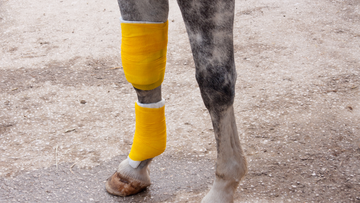Equine Leg Anatomy
Bone Structure
The leg of a horse is comprised of several different bones working with ligaments and muscles to generate speed and power. We can separate the leg into three different sections:
- Forelimb
- Cannon bone
- Pastern
Common Leg Injuries in Horses
Horses are an active species. Even in the wild, horses run, jump, and climb. In captivity, horses work on farms, perform jobs, and compete in athletic competitions.

Horses are prone to leg injuries because they are on them so much. Most often, horses experience sprains and strains. However, horses can suffer from fractures, usually in the cannon bone or fetlock joint. These injuries do not heal well due to a lack of blood flow.
Even if the injury heals, a horse can suffer from long-term inflammation and arthritis. A horse has the best chance if the injury is identified quickly and treated efficiently.
History of Treating Horse Leg Injuries
Traditional Methods
In earlier days, horses with severe leg injuries were often euthanized. If the horse could not continue to work, it was not useful to the owner. Oftentimes, people did not know the best way to treat a leg fracture.
In cases of minor injuries, splints and herbal treatments were used to help manage pain or wounds.
The most common treatment for horses was confinement. Confinement forces the horse to rest without physical challenges.
Overall, treatments for equine leg injuries were usually unsuccessful in returning a horse to full activity.
Advancements in Veterinary Medicine
With X-rays, MRIs, and other diagnostic tools, veterinarians can fully understand a horse’s injury. Additionally, treatments have advanced— including casting, screws, pins, and surgeries.
Thanks to advancements in veterinary medicine, veterinarians have significantly more training. While each case must be considered individually, veterinarians are much more prepared to handle all types of equine leg injuries.
Treatment Options for Broken Legs
Immediate Care and Stabilization
Identifying and treating a broken leg as quickly as possible is the best approach. First, immobilize the leg. You can use a splint or bandage. Additionally, you may need to administer pain medications until the veterinarian arrives. A veterinarian will evaluate the injury through a physical examination and imaging.
Surgical Interventions
When necessary, your veterinarian may recommend surgery. This will be the only option when the fracture is displaced and needs stabilizing through internal fixation such as plates, screws, and pins. Surgery is only an option when the horse is healthy enough to survive the surgery.
Rehabilitation and Recovery
Rehab will often be a part of the healing process if the fracture is left to heal or if surgery is performed. Physical therapists can help give you exercises to work on with your horse. Generally speaking, the length of rehabilitation varies based on the surgical treatment and the severity of the injury.
Euthanasia Considerations
Ethical Aspects
Recovery from a leg fracture is painful and grueling for a horse. In cases where the injury is going to cause severe long-term pain or has little chance of recovery, owners and veterinarians may choose to euthanize a horse to avoid this pain or a life of confinement.
Quality of Life Assessments
A horse deserves to live a pain-free life. If the prognosis is grim for the injury, euthanasia may be considered.
Economic Factors
It is a sad fact that money is an important factor. Treatment for an equine leg fracture can be incredibly expensive. Owners may choose to euthanize a horse instead of incurring a severe financial burden.






















